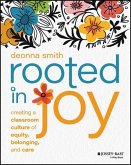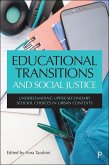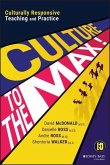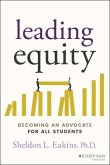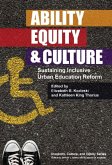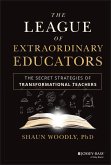- Broschiertes Buch
- Merkliste
- Auf die Merkliste
- Bewerten Bewerten
- Teilen
- Produkt teilen
- Produkterinnerung
- Produkterinnerung
Race and Place considers the everyday experiences of community members throughout the process of school desegregation and how race, place, and truth came to matter in this process in Prince George’s County, Maryland from 1945 through 1973.
Andere Kunden interessierten sich auch für
![Rooted in Joy Rooted in Joy]() Deonna SmithRooted in Joy20,99 €
Deonna SmithRooted in Joy20,99 €![Educational Transitions and Social Justice Educational Transitions and Social Justice]() A TarabiniEducational Transitions and Social Justice124,99 €
A TarabiniEducational Transitions and Social Justice124,99 €![Culture to the Max! Culture to the Max!]() David McDonald (Education PowerED)Culture to the Max!29,99 €
David McDonald (Education PowerED)Culture to the Max!29,99 €![Leading Equity Leading Equity]() Sheldon L. Eakins (Leading Equity Center)Leading Equity20,99 €
Sheldon L. Eakins (Leading Equity Center)Leading Equity20,99 €![Ability, Equity, and Culture Ability, Equity, and Culture]() Elizabeth B KozleskiAbility, Equity, and Culture35,99 €
Elizabeth B KozleskiAbility, Equity, and Culture35,99 €![The League of Extraordinary Educators The League of Extraordinary Educators]() Shaun WoodlyThe League of Extraordinary Educators20,99 €
Shaun WoodlyThe League of Extraordinary Educators20,99 €![The Dreamkeepers The Dreamkeepers]() Gloria Ladson-Billings (Madison University of Wisconsin)The Dreamkeepers18,99 €
Gloria Ladson-Billings (Madison University of Wisconsin)The Dreamkeepers18,99 €-
-
-
Race and Place considers the everyday experiences of community members throughout the process of school desegregation and how race, place, and truth came to matter in this process in Prince George’s County, Maryland from 1945 through 1973.
Produktdetails
- Produktdetails
- New Directions in the History of Education
- Verlag: Rutgers University Press
- Seitenzahl: 210
- Erscheinungstermin: 12. August 2025
- Englisch
- Abmessung: 226mm x 150mm x 15mm
- Gewicht: 322g
- ISBN-13: 9781978827998
- ISBN-10: 1978827997
- Artikelnr.: 72025229
- Herstellerkennzeichnung
- Libri GmbH
- Europaallee 1
- 36244 Bad Hersfeld
- gpsr@libri.de
- New Directions in the History of Education
- Verlag: Rutgers University Press
- Seitenzahl: 210
- Erscheinungstermin: 12. August 2025
- Englisch
- Abmessung: 226mm x 150mm x 15mm
- Gewicht: 322g
- ISBN-13: 9781978827998
- ISBN-10: 1978827997
- Artikelnr.: 72025229
- Herstellerkennzeichnung
- Libri GmbH
- Europaallee 1
- 36244 Bad Hersfeld
- gpsr@libri.de
DEIRDRE MAYER DOUGHERTY is a visiting assistant professor of educational studies at Knox College. She is the coauthor of The Fertile Ground of School Integration: A Counter-Story to Segregated and Unequal Education (forthcoming).
Contents
Introduction: Race, Place, and Truth
Part I: Spectral Spaces: Schooling Pre-Brown 1632-1950
1 “The Party of Memory and the Party of Hope”: Contradiction in Black and
White
2: Public Schooling in Maryland before Brown
Part II: A Policy of Nostalgia (1954-1968)
3: Thomas Pullen and Gradual Adjustment
4: William Schmidt and The Freedom of Unequal Choices, 1960-1968
Part III: Mythologizing the Neighborhood
5: White Suburbanization and School Construction in Belair at Bowie,
1920-1965
6: Black Suburbanization: School Closure and Urban Renewal in Fairmount
Heights, 1920-1968
Part IV: Moralizing Space and Race
7: The Moral Geography of Busing, 1972
8: Discipline, Danger, and Desegregation, 1973
Conclusion: “…cleaner, whiter, richer, safer than where you are”
Acknowledgments
Notes
Bibliography
Index
Introduction: Race, Place, and Truth 1
Part I Spectral Spaces: Schooling Pre-Brown
(1632–1950)
1 “The Party of Memory and the Party of Hope”:
Contradiction in Black and White 21
2 Public Schooling in Maryland
before Brown 28
Part II A Policy of Nostalgia (1954–1968)
3 Thomas Pullen and Gradual Adjustment 45
4 William Schmidt and the Freedom of Unequal
Choices, 1960–1968 58
Part III Mythologizing the Neighborhood
5 White Suburbanization and School Construction in Belair
at Bowie, 1920–1965 71
6 Black Suburbanization: School Closure and Urban Renewal
in Fairmount Heights, 1920–1968 92
Part IV Moralizing Space and Race
7 The Moral Geography of Busing, 1972 119
8 Discipline, Danger, and Desegregation, 1973 132
Conclusion: “. . . cleaner, whiter, richer, safer than where you are” 146
Acknowledgments
151
Notes 155
Index 000
Introduction: Race, Place, and Truth
Part I: Spectral Spaces: Schooling Pre-Brown 1632-1950
1 “The Party of Memory and the Party of Hope”: Contradiction in Black and
White
2: Public Schooling in Maryland before Brown
Part II: A Policy of Nostalgia (1954-1968)
3: Thomas Pullen and Gradual Adjustment
4: William Schmidt and The Freedom of Unequal Choices, 1960-1968
Part III: Mythologizing the Neighborhood
5: White Suburbanization and School Construction in Belair at Bowie,
1920-1965
6: Black Suburbanization: School Closure and Urban Renewal in Fairmount
Heights, 1920-1968
Part IV: Moralizing Space and Race
7: The Moral Geography of Busing, 1972
8: Discipline, Danger, and Desegregation, 1973
Conclusion: “…cleaner, whiter, richer, safer than where you are”
Acknowledgments
Notes
Bibliography
Index
Introduction: Race, Place, and Truth 1
Part I Spectral Spaces: Schooling Pre-Brown
(1632–1950)
1 “The Party of Memory and the Party of Hope”:
Contradiction in Black and White 21
2 Public Schooling in Maryland
before Brown 28
Part II A Policy of Nostalgia (1954–1968)
3 Thomas Pullen and Gradual Adjustment 45
4 William Schmidt and the Freedom of Unequal
Choices, 1960–1968 58
Part III Mythologizing the Neighborhood
5 White Suburbanization and School Construction in Belair
at Bowie, 1920–1965 71
6 Black Suburbanization: School Closure and Urban Renewal
in Fairmount Heights, 1920–1968 92
Part IV Moralizing Space and Race
7 The Moral Geography of Busing, 1972 119
8 Discipline, Danger, and Desegregation, 1973 132
Conclusion: “. . . cleaner, whiter, richer, safer than where you are” 146
Acknowledgments
151
Notes 155
Index 000
Contents
Introduction: Race, Place, and Truth
Part I: Spectral Spaces: Schooling Pre-Brown 1632-1950
1 “The Party of Memory and the Party of Hope”: Contradiction in Black and
White
2: Public Schooling in Maryland before Brown
Part II: A Policy of Nostalgia (1954-1968)
3: Thomas Pullen and Gradual Adjustment
4: William Schmidt and The Freedom of Unequal Choices, 1960-1968
Part III: Mythologizing the Neighborhood
5: White Suburbanization and School Construction in Belair at Bowie,
1920-1965
6: Black Suburbanization: School Closure and Urban Renewal in Fairmount
Heights, 1920-1968
Part IV: Moralizing Space and Race
7: The Moral Geography of Busing, 1972
8: Discipline, Danger, and Desegregation, 1973
Conclusion: “…cleaner, whiter, richer, safer than where you are”
Acknowledgments
Notes
Bibliography
Index
Introduction: Race, Place, and Truth 1
Part I Spectral Spaces: Schooling Pre-Brown
(1632–1950)
1 “The Party of Memory and the Party of Hope”:
Contradiction in Black and White 21
2 Public Schooling in Maryland
before Brown 28
Part II A Policy of Nostalgia (1954–1968)
3 Thomas Pullen and Gradual Adjustment 45
4 William Schmidt and the Freedom of Unequal
Choices, 1960–1968 58
Part III Mythologizing the Neighborhood
5 White Suburbanization and School Construction in Belair
at Bowie, 1920–1965 71
6 Black Suburbanization: School Closure and Urban Renewal
in Fairmount Heights, 1920–1968 92
Part IV Moralizing Space and Race
7 The Moral Geography of Busing, 1972 119
8 Discipline, Danger, and Desegregation, 1973 132
Conclusion: “. . . cleaner, whiter, richer, safer than where you are” 146
Acknowledgments
151
Notes 155
Index 000
Introduction: Race, Place, and Truth
Part I: Spectral Spaces: Schooling Pre-Brown 1632-1950
1 “The Party of Memory and the Party of Hope”: Contradiction in Black and
White
2: Public Schooling in Maryland before Brown
Part II: A Policy of Nostalgia (1954-1968)
3: Thomas Pullen and Gradual Adjustment
4: William Schmidt and The Freedom of Unequal Choices, 1960-1968
Part III: Mythologizing the Neighborhood
5: White Suburbanization and School Construction in Belair at Bowie,
1920-1965
6: Black Suburbanization: School Closure and Urban Renewal in Fairmount
Heights, 1920-1968
Part IV: Moralizing Space and Race
7: The Moral Geography of Busing, 1972
8: Discipline, Danger, and Desegregation, 1973
Conclusion: “…cleaner, whiter, richer, safer than where you are”
Acknowledgments
Notes
Bibliography
Index
Introduction: Race, Place, and Truth 1
Part I Spectral Spaces: Schooling Pre-Brown
(1632–1950)
1 “The Party of Memory and the Party of Hope”:
Contradiction in Black and White 21
2 Public Schooling in Maryland
before Brown 28
Part II A Policy of Nostalgia (1954–1968)
3 Thomas Pullen and Gradual Adjustment 45
4 William Schmidt and the Freedom of Unequal
Choices, 1960–1968 58
Part III Mythologizing the Neighborhood
5 White Suburbanization and School Construction in Belair
at Bowie, 1920–1965 71
6 Black Suburbanization: School Closure and Urban Renewal
in Fairmount Heights, 1920–1968 92
Part IV Moralizing Space and Race
7 The Moral Geography of Busing, 1972 119
8 Discipline, Danger, and Desegregation, 1973 132
Conclusion: “. . . cleaner, whiter, richer, safer than where you are” 146
Acknowledgments
151
Notes 155
Index 000


